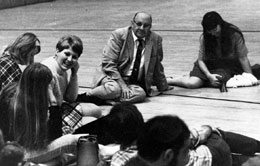Volume 27 · Number 4 · Summer 2010
Rebels with a Cause: A 'Cordial' Campus
In 1968, when Ed Costantini was on the UC Berkeley campus, he saw National Guard troops, helicopters and tear gas used on student protestors. “I thought the world was coming to an end.”
Costantini, a professor emeritus of political science, joined the UC Davis faculty in 1964. In 1966, during a tumultuous time of protests, he served a one-year-stint as education secretary for Gov. Pat Brown. The next year, with Ronald Reagan’s election as governor, the UC Board of Regents controversially dismissed UC President Clark Kerr for perceived leniency with student protestors.

File photo of Chancellor Emil Mrak sitting on a gym floor with students.
In the 1960s, campus administrations at places like Berkeley were often “pitted against the students” and the conflict was more “in your face,” Costantini said. “Can’t you control those hippies?” was often the question.
Back at Davis, things were a little more civil, he said. A 1960s file photograph from this magazine shows then-UC Davis Chancellor Emil Mrak, in the face of mounting anti-war protests on the Davis campus, sitting down and casually talking with students on a gym floor. The caption reads: “(Chancellor Emil) Mrak adopted an approach that provided opportunities for students to work with faculty and administrators for peaceful change at every level of university life.”
In 1969, the campus went on strike to protest the violence at UC Berkeley that resulted in one death and massive arrests. Though he encouraged students to stay in class, Chancellor James Meyer told them, “I am with you.”
Four decades later, the UC Davis administration took similar steps — working out the logistics with students for the Shields Library weekend sleepover, standing by March 4 as student protestors shut down the campus bus system for a half hour, and then allowing them to march unimpeded to within yards of Interstate 80, and on other days allowing them to occupy buildings for hours-long sit-ins.
“Protests are always a measure of the times,” Costantini said.
